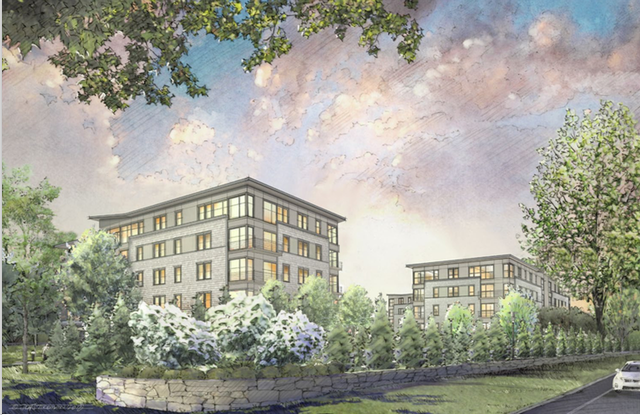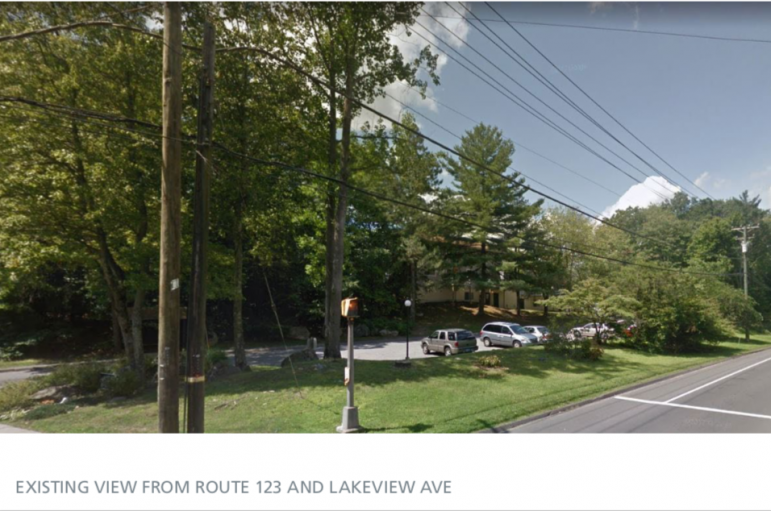Saying a new exterior design represented a major improvement if not an acceptable final version, the Planning & Zoning Commission on Tuesday night unanimously approved the redevelopment of Canaan Parish, a 60-unit housing complex at Lakeview Avenue and Route 123.
Addressing concerns voiced by P&Z at an initial public hearing last month, officials representing the applicant— the 5.2-acre property is owned by the town and an organization called ‘New Canaan Neighborhoods’ owns the buildings—reduced the height of two new buildings proposed for the site by six to seven feet, added architectural features for a more local residential feel, toned down the color scheme and increased screening from the street with more robust landscaping.
In the end, the redevelopment is expected to achieve one major goal of the town as well as the New Canaan Housing Authority, which is partnering with New Canaan Neighborhoods on the project—namely, to ensure that New Canaan doesn’t open itself up to a loophole in a state law that allows developers to ignore local planning decisions in places that do not meet strict affordable housing requirements.
Plans call for rebuilding the 60-unit Section 8 housing complex in a single five-story structure and construction of a new, 40-unit structure of the same height that would count toward the state’s affordable housing requirement. New Canaan is never expected to reach a guideline whereby 10 percent of its housing stock qualifies as “affordable” under the state’s rigid definition, though the town by creating additional qualifying units at Mill Pond has earned four years of relief from the developer loophole. The Canaan Parish project would help attain a second four-year moratorium, and lay the groundwork for a possible third.
Its redevelopment is noted specifically in New Canaan’s guiding document for planning, the Plan of Conservation and Development or ‘POCD,’ P&Z Chairman John Goodwin noted at the group’s regular meeting.
“So we are achieving one of the key objectives of the Plan,” Goodwin said during the three-hour meeting, held at Town Hall.
“I also think that this definitely achieves the objectives of public health, safety and welfare and, quite frankly, property values. Some of the public might disagree with me, but I think a nice redeveloped project in town will improve property values. I also like the fact that—as the applicant pointed out, right now the kids play in the parking area, they don’t have a separate space—my view is that open space is a good thing. I also think it’s a good thing that we have more families in New Canaan. Another objective of the POCD is to provide workforce housing. This is a segment of our population that we have to be able to [house] and that is exactly what this project is for.”
P&Z voted 9-0 three times: for a text change to the New Canaan Zoning Regulations establishing the ‘Canaan Parish Housing Zone,’ for a change in zoning boundaries of 186 Lakeview Ave. (which currently is in the multifamily zone, under the regs) and for the site plan itself. Those voting in favor included Krista Nielson, John Kriz, Bill Redman, Jack Flinn, Secretary Jean Grzelecki, Goodwin, Laszlo Papp, Dan Radman and Kent Turner. The effective date of the measures is Sept. 20.
Even with the yes votes, it isn’t clear just what the buildings will look in the end.
As part of the approval, P&Z gave itself time to work with the project’s architects on finalizing the exterior. The commission typically states its preferences in such cases to the town planner and defers a final decision to him or her, though Goodwin appeared to suggest that the professional architects on P&z—Papp, Radman and Turner—could meet with the applicant to review plans. Such a gathering that would seem to qualify as a public meeting under state sunshine laws. No firm date was set, though as one member of the project team noted, Dec. 6 is a “key milestone date” for the application. According to David McCarthy, president of Heritage Housing Inc., a consulting firm assisting on the project, that’s the hard date that the state would need to get an application related to the moratorium, and site plan approval is part of it.
Papp indicated that prior to the meeting he’d seen a version of the new buildings that he found more in keeping with New Canaan’s aesthetic than what the architect on the project—Amenta Emma Architects of Stamford—brought forward on the applicant’s behalf.
While that plan represents “a big improvement” from the original version, Papp said, a different rendering featured slanted roofs, dormers “and other architectural features” that relate better “to some of the existing buildings in town.”
“I am very disappointed that that sketch disappeared from consideration,” Papp said. “Why is that?”
Myles Brown, a principal at Amenta Emma, responded that while he also liked the plan, it also didn’t work for two reasons. First, he said, “it deviated from the design mission, which was to create maximum natural light and a light airy feel,” because a “dormered” top floor wouldn’t have big windows. Second, it’s more expensive. A flat roof that drains in the center is cost-effective, whereas adding more features requires additional gutters, eaves and flashing.
“So it’s an aesthetic articulation that doesn’t add value to the mission and we were trying to achieve for the project,” Brown said.
Echoing some of what he had said to the Town Council at a recent meeting, Housing Authority Chairman Scott Hobbs hit some of the same points as Brown. Hobbs described himself as a fourth-generation New Canaanite and said those on the boards of the organizations involved have been in town for decades, “so this is not a group of interlopers coming in and trying to destroy New Canaan.”
“It’s people who really care and are trying to create something that is really special. And when we first started gravitating toward a more contemporary design, i was the most depressed because I knew we would have to stand in front of you and I had no illusions about the fact that this wasn’t going to go over very easily. And yet each time we went back and kept checking on the different options for the buildings, trying to do peaked roofs, I mean there was one design that we almost came up to, we had one version of the peaked and unfortunately as you kept looking at it, you kept going, ‘All the peaks were unnecessary.’ And once that is exposed to you, the more you look at it, you are going, ‘We are creating a Disneyland facade.’ And that is not what we wanted to come up with.”
For many in New Canaan, the original design plan for Canaan Parish surfaced following critical comments from Selectman Kit Devereaux during a Board of Selectmen meeting. The original design “definitely does look like New Canaan,” Devereaux said at the time—an opinion that some on P&Z echoed during last month’s hearing. P&Z’s criticism focused on the exterior of the buildings, with members referring to its “skin,” and the Commission also called for more of a landscape buffer between the rebuilt Canaan Parish and Route 123.
Even so, members of P&Z offered high praise for the proposed new site plan at Canaan Parish, which provides a circular driveway running through the complex, a dedicated play area, spots for residents to gather outside and far more open space than it has now.
Ginny Apy, a resident at Canaan Parish, said the improvements in building design were “tremendous.” Even so, Apy said it was a shame that the new design wasn’t unveiled until the very night that the public hearing on the Canaan Parish would be closed, and that no one yet knows what the final look will be. She thanked the applicant team for its improvements and thanked P&Z for the work it was putting in.
During the hearing, P&Z commissioners asked how the applicant arrived at projections for how many school-age children would live at a larger Canaan Parish complex (using the number of kids now there as a baseline rate), whether that figure would be more accurate using updated enrollment projections (the numbers can be run in any way P&Z wants), whether the square footage of various types of units are determined by the state (yes), whether the buildings could be spread out on the lot so that each one wouldn’t be as high (that’s cost-prohibitive, in part because it wouldn’t allow current residents to remain on site through construction), whether the upper stories could be “peeled back” to give more shape to the buildings (that complicates a simple design and also creates additional costs, such as with new stairs), why the project needs a text change to the regulations rather than a Special Permit (that’s how P&Z typically handles these applications) and whether the ceiling height in each apartment could be reduced (preferably not).
Brown in reviewing the new design said more windows had been added to the upper levels “to differentiate it” and compensate for a projected lack of balconies, though “perhaps” the upper levels would get Juliet balconies.
“We have also further developed and broken down the scale of the architecture through trim and detailed articulation around the windows,” Brown said.



This design is so much better and lighter than the brown awful buildings originally designed. Please note that the ‘more robust plantings’ in front are exactly the same, just enlarged to cover more lower floors than before. Made me laugh.
Perhaps the headline should be “P&Z approves a five-story apartment building”?
Its interesting to see the 1977 article in the NYT on the first buildings here.
https://www.nytimes.com/1977/04/15/archives/subsidized-new-canaan-housing-gains-approval-of-town-council.html
Still not much discussion on the total financial cost of this project; the logistics on how you tear buildings down, and rebuilding down a narrow roadway with five dozen families and individuals trying to live amidst these new challenges.
And where is the logistical rigor in mapping out the necessity of this vs. the consequences of not meeting the deadlines? We keep hearing of dire scenarios if the town does not expand the affordable or HUD housing and yet none of these have been explicitly hashed out in terms of likely problem developments. What is their evidence of this? Wouldn’t planning and zoning be able to head off more unattractive and excessive developments? And builders are not stupid, they aren’t going to put up unprofitable and also unpopular developments.
Strangely, “New Canaan Housing Authority” was ready to rush through not just the proposed demolition and rash ugly 40 unit expansion, but with provisions for even more units in the future to circumvent problems with the state mandate; and they probably would have succeeded were it not for a few concerned local politicians.